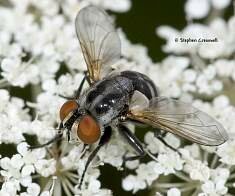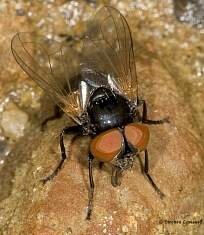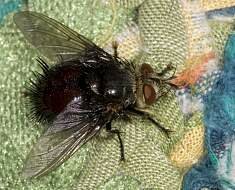West Virginia Tachinid Flies
Family Tachinidae
Many Tachinid Flies are like the House Fly Musca domestica in general appearance. Many Tachinids are bristly, and some resemble bees.
If you have a calyptrate fly with a bare arista, you have a Tachinid fly. Unfortunately, some Tachinids do not have a bare arista, in which case other traits must be used for identification to family. Some of these other traits of Tachinids are easier to see with a pinned specimen and a hand lens; they include a developed postscutellum and the presence of hypopleural bristles.
In Tachinid fly wings cell R5 is closed (or sharply narrowed) distally; this trait is shared with Blow flies and some Muscids.
Though no common name has really caught on for this family, some writers have proposed the name Parasitic Flies, since all Tachinid larvae develop within the bodies of insects (rarely centipedes, and possibly scorpions and spiders). Caterpillars are the larvae most commonly parasitized, but beetle larvae, bug nymphs, various adult insects, and others also fall victim to Tachinid flies.
In some cases Tachinds lay eggs on a leaf, and from the leaf the eggs are consumed by a larval insect. The eggs then hatch within the host's body, and feeds there without killing the host until the fly is mature and emerges. In other cases the Tachinid fly's ovipositor pierces the side of the host's body and injects the eggs there. In a few cases mother Tachinid injects larvae rather than eggs into the host.
Because of their role in slowing and eventually killing caterpillars, grubs, and various pest insects, Tachinids are considered economically beneficial in agriculture and forestry.
Arnett (2000) says of the Tachinidae, "This would probably be the largest family of flies if the many undescribed species were included with the 1277 species now known from the U.S. and Canada."
Click on the thumbnail to see a larger version with information about the species.
| Tachinidae of West Virginia |
| 1 2 |


Insects of West Virginia










